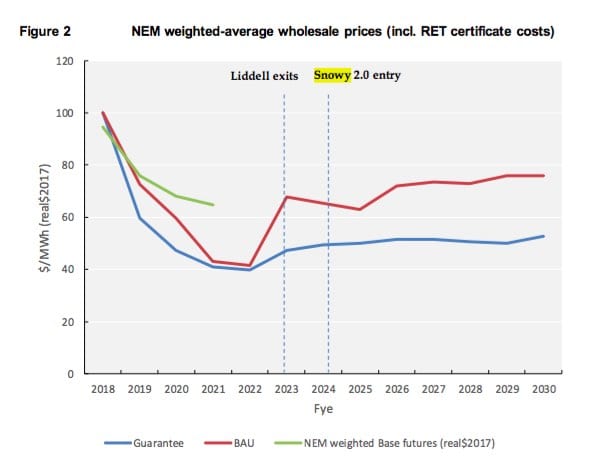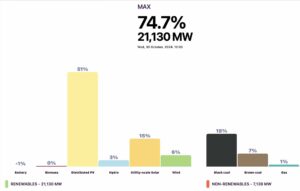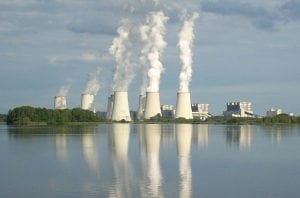The latest modelling for the federal Coalition’s proposed National Energy Guarantee confirms the new policy would effectively shut the door on new renewable investment at national level in the next decade.
The modelling – included in a new 50 page document prepared by the Energy Security Board for the COAG energy ministers meeting on Friday – suggests that the NEG is barely better than doing nothing.
In its low demand scenario, doing nothing would meet the government’s emissions targets just as effectively as the NEG, the modelling shows. Adopting the NEG would add an extra 1 per cent of renewable capacity over doing nothing over a whole decade.
“Both BAU and the Guarantee achieve the emissions reduction target under the ‘low demand’ scenario,” it says. And that would mean no need for any new wind or solar.
In its most optimistic scenario (see table below), the NEG would add just 4 per cent of additional renewable capacity over business as usual – yet even this modelling appears to underestimate the uptake of rooftop solar. So the incentive for new large-scale investment is largely illusory.
The government sought to sell the document on Wednesday as an avenue for a “cleaner, cheaper, reliable energy,” saying that household bills could fall by $400 a year and businesses benefit from a price cut of up to 30 per cent.
But the modeling shows that these cost reductions are delivered almost entirely ($280 a year in the case of households) by the very policy that the Coalition tried to kill – the renewable energy target – and will largely happen anyway.
“The steep decline in wholesale prices under both BAU and Guarantee from 2018 to 2022 is due to the committed entry of almost 6,000MW of renewable capacity across the NEM, principally incentivised by the existing Renewable Energy Target,” it says.
The Coalition is assuming added cost benefits ($120 a year) from the NEG, from around 2022 on, but only on the basis of some modelling gymnastics that somehow assumes that the cost of wind and solar will be more than 20 per cent more expensive if there was no NEG in place.
There is huge irony in this. Conservatives and other renewable energy critics have always denied that renewables will bring price benefits.
It has underpinned their refusal to lift emissions reduction targets, and their refusal to introduce an emissions intensity scheme, or a clean energy target and underscored their commitment to try to kill the RET.
This modelling shoots those claims right out of the sky. Some may doubt that wholesale prices may sink this low – due to the role of gas generators and the greed of the utility oligopoly, but it confirms that any price reductions will be driven by renewables.
And it underlines the point that if it wasn’t for the three-year renewable energy investment strike engineered by the Coalition, then those savings would already be enjoyed by consumers. They now have to wait until next year.
And the modelling will make people ask why we are now turning for the fourth, fifth or sixth best policy.
And, more profoundly, it kills virtually all the arguments that the Coalition ever had to fight a higher emissions reduction target.
The case for the NEG is further undermined by the storage report released by chief scientist Alan Finkel earlier this week that points to the very small amount of storage needed even for a 50 per cent renewable energy target – storage that might be provided by household investments that would happen anyway.
This document, then, will do little to salve the concerns of the states and the renewables industry that this is a policy designed to protect coal rather than encourage new investment.
They will ask what the point is of a policy that appears incapable of adding anything, or very little, beyond “doing nothing.”
South Australia, already at 50 per cent renewables and in the midst of a new investment boom in wind, solar and storage, is particularly appalled.
S.A. energy minister Tom Koutsantonis says the NEG will entrench the monopoly market power of existing fossil fuel generators and retailers, limiting competition and driving up power prices in South Australia.
“It proves it would make it more difficult for new competition from renewables to enter the market and takes Australia in the wrong direction. “
The ability of big utilities to entrench their market power through a series of contracting for both emissions and reliability obligations is one of the main concerns for the industry, and the reason they are convinced that the NEG would cause prices to rise rather than fall.
And the ESB appears to recognise this. The 50-page report includes a special section on South Australia that acknowledges the issue of competition in the market, and even contemplates a new rule to limit market share, although it has no idea how or if such a mechanism could be implemented.
And it’s not just South Australia that suffers this problem. Many other states also suffer from a few dominant players, as the recent analysis by the ACCC and any number of analysts has identified, and the ability of the big players to game pricing has been highlighted by governments, regulators, consumers and the utilities themselves.
Yet the ESB admits: “It is difficult to predict whether additional contracts will be supplied by existing generation or by new capacity.“
There are a whole lot of issues around the modelling, which we go into in a separate story – notably the modelling about rooftop solar and storage, and its assumption that there will be zero investment in storage in business as usual (which is plain nonsense), its assumption that Snowy 2.0 will be up and running in six summers time, and its cost data.
These inconsistencies, and its evident rushed nature, will raise suspicion and alarm ahead of the COAG meeting, just as many in the industry were willing to explore the possibilities further, arguing that if certain conditions were met – and there are a lot of them – then it might just work.
The document does not allay the main suspicion that lies around the Coalition’s motive for the NEG; namely that it was a rushed response to a sudden decision by prime minister Malcolm Turnbull that he dare not take on the Coalition’s hard right and push for Finkel’s Clean Energy Target.
The modeling, to be sure, is angled to please that particular constituency. As the briefing to COAG admits, the ESB has designed the mechanism “in a manner that is consistent with governments’ energy policy objectives.”
It assumes a bare minimum effort on climate out to 2030, and no effort after that, and on this modelling it is impossible to work out whether it could produce a more agreeable result if a higher emissions target were dialed in to the equation.
It may be that Turnbull simply wants to kick the energy policy can down the road. The final design of the proposed framework – according the document – is not expected to be ready until the second half of 2018, by which time a federal poll may already have been called, or the country well in truly in election mode.
In any case, if the states do agree this Friday for the ESB to do further work, the states will need to take greater control of the direction that it is moving.
Primarily, they need to instruct the ESB to model what might happen post 2030, and if greater ambition is dialed in before 2030 to confirm the ESB claims that it will have the flexibility to respond and not penalise wind and solar.
Other groups have also been coming to the party, saying they are willing to look at it, but there is a growing list of “deal-breakers” that will prevent their support once the details are defined.
These are not dissimilar to the 30 reasons to question the NEG that we published soon after the release, but the focus is on:
– It must provide a clear signal for new renewable generation, and it must also combine this with sensible and ambitious energy efficiency and demand management policies. It must allow the states to develop their own policies if the federal ambition is not strong enough.
– It must provide no avenue for retailers to buy international offsets to meet their emissions targets.
– No soft RET-like penalties if they fail to meet those obligations. Any unmet emissions obligations should be handled by the regulator who would then conduct an auction for new wind or solar capacity.
– Observance of the Australian Energy Market Operator’s annual ESOO report for the obligation requirement. That may mean, according to an ESB response to questions posted after its webinar, that no obligations need to be imposed in regions that don’t need it.
“If there is no reliability issue in a particular state then the reliability obligation won’t be imposed,” it says. It needs to hold true to that, because, if AEMO is to be believed (along with Finkel and the CSIRO), there is virtually no region at all, after the next two summers, that will need such a requirement.
– There must be no squibbing by using existing hydro to meet emission reduction targets. It has to be new generation.
– It must not only provide a clear signal for new generation, it must also combine this with sensible and ambitious energy efficiency and demand management policies.












